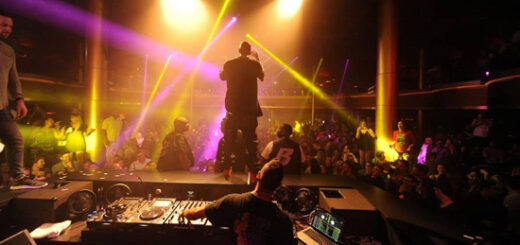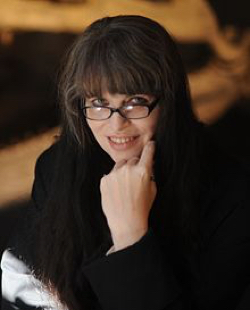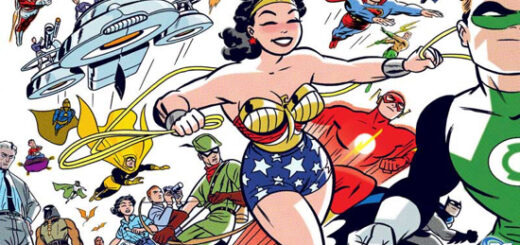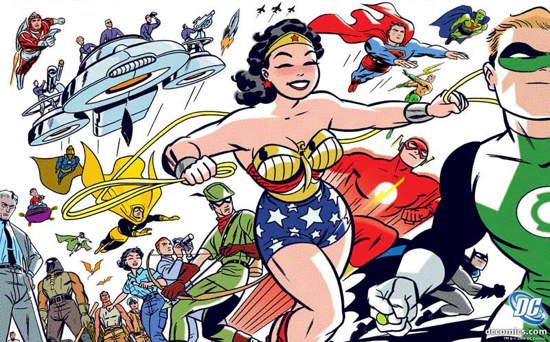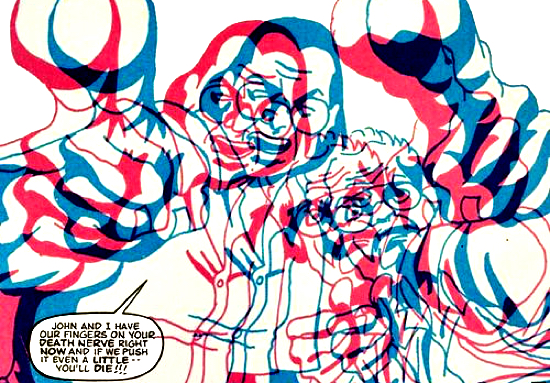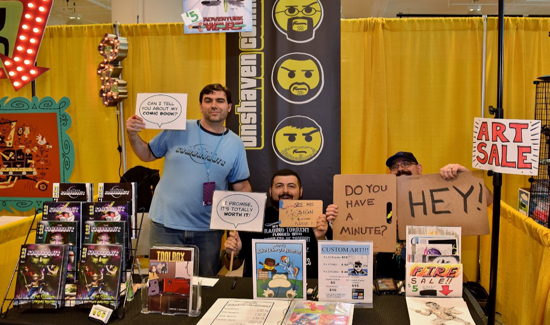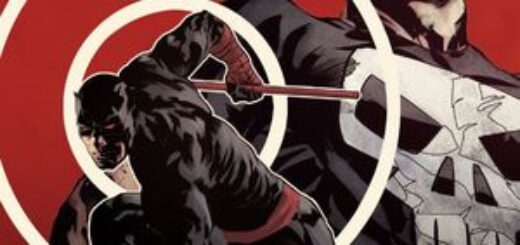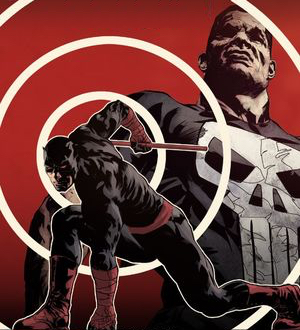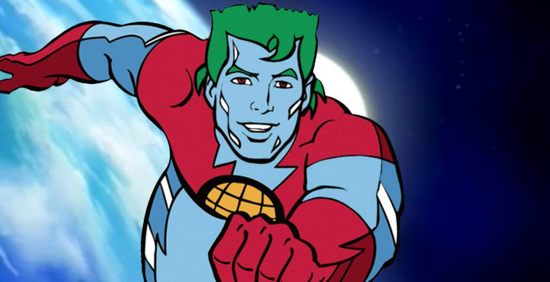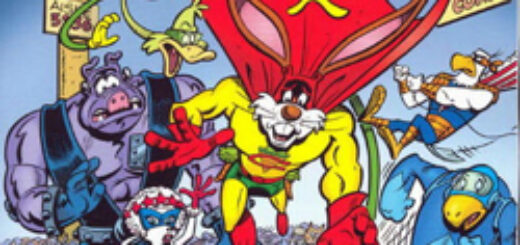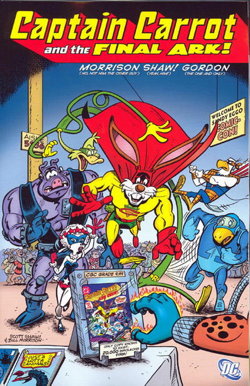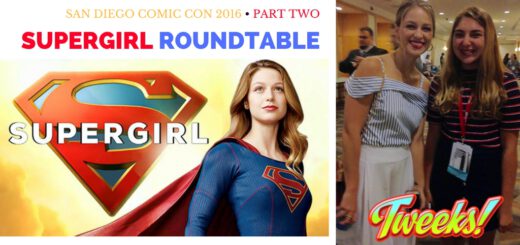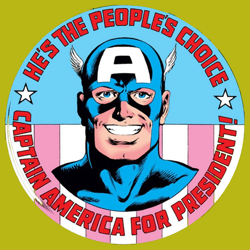Emily S. Whitten: Convention Catch-Up — Yay, Dragon Con!
Time flies, doesn’t it? It seems like just yesterday I was watching Animaniacs Live, interviewing folks about Turtles and cartoons, seeing the latest in geek fashions, hanging out with American Gods, and chatting with the Kings of Con at SDCC, not to mention chillin’ at Nerd HQ. And now suddenly it’s September, and I’ve since attended both the UK Discworld Convention and Dragon Con! Convention season: it really never stops, does it?
Despite my busy schedule, I don’t want to miss sharing any of the fantastic adventures I’ve been having with you; so first, let’s rewind to San Diego and reminisce about the summer party-party-parties, because they are a staple of SDCC and deserve to be featured. Every year, I try to line up at least a couple of parties each night, because, let’s be frank, I just love a good party. (I also often wish I could be in two places at once so I could go to even more parties. Alas that it’s impossible.) Although occasionally I don’t make it to one I really didn’t want to miss, it’s mostly because I’m having too much fun at another one – a good problem to have!
This year, I missed a few that were totally on my list; but I did manage to hit several super-fun ones…
Wednesday:
When you go to a con every year, you sometimes end up with con traditions, which can make the experience even better. On SDCC Wednesdays, my awesome friend Amy and I have turned going to BASIC for pizza and the Gabe Eltaeb Comic Kickoff Fundraiser into our own little tradition. The fundraiser is cool, with artists on hand sketching and neat auction items; the pizza is good and relatively quick to appear (very important after preview night!), and this year, BASIC was a Pokestop, so while we waited for our order we amused ourselves by catching Pokemon (I caught one of the pretty horse ones and named him Ricotta after our pizza). Definitely a good chill hangout start to the con.
Thursday:
Sometimes it’s good to get in the right frame of mind before a night of going out. On Thursdays, the WIRED Café, which runs from 11am to 7pm, is a good place for that. The downside is that it’s usually a bit of a wait to get in – to the point where last year I took a look at the wait and opted for other choices. But this year I stuck out the line, which was moving at a decent clip, and went on in. The WIRED Café was a fun combo of food and drinks, a DJ and little dance floor, and nifty interactive tech toys (plus a handy phone charging station). The gadgets you could play with included a VR Mars walk experience, and a Sphero BB-8 that could be controlled by head movements. They also had some really good specialty sno-cone drinks. (And if you got a marked coaster you won a shirt. I won on the first drink!) All-in-all it was fun, although I’d definitely weigh the wait against other stuff you might want to see on Thursday.
Once the day was properly in evening party mode, I hit up the Scholastic Party, which was celebrating a number of its newest Graphix publications on the Hotel Palomar pool deck. The pool deck had a nice setup and the party had neat features (along with welcome food and drinks) like a hefty swag bag and free Day of the Dead-style face painting. Well, I can’t resist free face painting, so of course off I went to get a super-cool design on my face (and then had to figure out how to eat and drink without messing it all up!). There were also several great guests there, like the super-nice Greg Grunberg (who told me I should never wash my face again, because the face paint was so cool), Dustin Nguyen, and Kate Beaton. I also ran into other fun folks there, like Sanford Greene, Simon Fraser, Edie Nugent, Patrick Reed, Amy Chu, and Batton Lash. Altogether it was a great party.
After it wound down ComicMix editor Adriane Nash and I hit up the NVE & Nylon Magazine After-Con Party. Celebrating the Women of Wonder, at Omnia. This was a full-fledged club party, with lots of celebs wandering around, and a fun time was had by all. The face paint was a big hit, and we chatted with everyone from Mehcad Brooks (Supergirl’s James Olsen, who was really happy to hear that Adriane liked what he’s doing with the character) to Teen Wolf’s Cody Christian (what a sweet guy). We also spotted others from the Teen Wolf cast, DJ Qualls, and Casper Van Dien – and I’m sure there were a ton of folks we literally rubbed elbows with, even if we didn’t realize it. It was packed! The party also featured Kristian Nairn from Game of Thrones as a DJ, with a surprise visit from DMX later in the evening; and a video booth where you and friends could take slow-mo “superhero” videos together with props. Closing that party down was a solid end to the night.
Friday
Friday night I somehow managed to fit three parties in (harder than it sounds!). I started out with the excellent Starz American Gods and Ash vs. Evil Dead cocktail party on the rooftop at Rustic Root, which I wrote about in detail in my American Godscolumn. This party had a themed drink, cool swag bags, and lots of American Gods and Ash folks, as can be seen here. Definitely a good time.
When that party wrapped, I hightailed it over to the SherlockeDCC party at the San Diego Central Library, organized by the Baker Street Babes, Sherlock DC, and NerdOut. This party featured themed drinks, vendors, a raffle of Sherlockian items, and an appearance by Steven and Louis Moffat. Every year I enjoy this party, where I always run into friends like fellow DC-area fan Lacy, and the esteemed Sherlockian Les Klinger. This year I was also extremely delighted to catch up, at least for a little while, with my North American Discworld Convention co-founder Anna, who I hadn’t seen in years, and who was, as always, decked out in the best costume; and our fellow NADWCon friend Shari. Love those ladies!
Although I hated to leave SherlockeDCC, I didn’t want to miss Nickelodeon’s Marc Summers & Double Dare Party at Fluxx. And that was a good choice, because it was epic amounts of fun. I wrote all about it in my Nickelodeon column, but to recap: they had Actual Marc Summers (who did not miss a beat the whole time) running an Actual Game of Double Dare on the dance floor at a hip nightclub, and the Red Team and Blue Team were comprised of Actual Nickelodeon People, including TMNT’s Mikey, voice actor Greg Cipes. Not to mention they provided us hungry con-goers with the best tiny diner food (burgers, fries, shakes, etc.). And that cool cats like TMNT’s Ciro Nieli and Eric Bauza were on hand to chill with. And that at the end of the night, they cleared the dance floor of all the cool Double Dare stuff (like the giant hamster wheel) and we all danced our hearts out to ‘90s music. Like I said, epic.
Saturday
Oh man. There were lots of cool-sounding parties on Saturday – including the HBO party, which fellow ComicMixers attended. But being totally honest here, by that point I was wiped. So instead of partying hard, I went out and had a niiiiice, relaaaaxing dinner with friends, followed by very chill drinks with other friends. And that? Totally rocked too. Woo!
Well that pretty much wraps up my SDCC experiences, although there are even more photos from the parties and the con floor in my SDCC photo collection. So check that out!
And now, on to the…
UK Discworld Convention
Going to the UK Discworld Con was something I looked forward to, but it was also tough – being the first Discworld event I’ve attended since Terry Pratchett passed away last year. I admit I still expected to see him around every corner, chatting with a fan or having a drink at the pub. And I admit that I needed a little more downtime than I usually do at cons, to deal with Terry not being there. But I’m so, so glad I went – both because the con featured many events that honored and memorialized Terry, and because it was really nice to reconnect with my many Discworld friends, and even make some new ones. One of the best parts of Discworld Cons is hanging out at the pub with your friends, and I was happy to be able to spend time with the likes of guests Rob Wilkins, Colin Smythe, Bernard Pearson, Reb Voyce, Ian Mitchell, Ian Stewart, Stephen Briggs, and Daniel Knight, and panelists Diane Duane, Peter Morwood, and David Bradshaw; as well as with my many fantastic convention friends. Discworld Cons are such a wonderful thing, and after going to the UK Con, I’m even happier that I’m involved in running the next North American Discworld Convention, which is happening next Labor Day weekend in New Orleans.
The con started with an opening ceremony in which The Hat was brought to the main stage, where it remained for the rest of the con. Among the most important panels were the programs that honored Terry. In one, selected clips from the memorial that was held for Terry last April were shown; including one of Good Omens co-writer Neil Gaiman reading from his intro to A Slip of the Keyboard; which is still one of the best summations of Terry that I’ve read. In another, Terry’s good friend Bernard Pearson of the Discworld Emporium told wonderful stories (as is his wont) of times he and Terry spent together (including that time they went in search of a specific type of pub urinal. No really). And then there was a good conversation between Terry’s longtime PA and business manager Rob Wilkins, and Discworld audiobook voice, playwright, and reference book collaborator Stephen Briggs, about their many recollections of Terry. And, of course, the tradition of the Bedtime Stories was continued; and although there will sadly be no more books, Rob read us all a bit of what could have been another story, had there been more time.
It wasn’t all about looking back, though. Although in documentarian Charlie Russell’s panel it was absolutely fascinating to hear him discuss with Rob Wilkins the previous three documentaries he made about and with Terry, he also talked about the new documentary he is doing with the BBC – about Terry’s legacy and the fandom, some of whom he interviewed while at the con. And although Terry’s independent production company Narrativia no longer has Terry to guide it, in the Narrativia Klatch we heard from two of its members, Rod Brown and Rob Wilkins (Rhianna Pratchett being the third), about exciting upcoming projects like The Wee Free Men, which is being adapted for the big screen by Rhianna Pratchett and developed with The Jim Henson Company; Good Omens, which is being adapted for TV by Neil Gaiman; and The Watch TV series, which is also currently in development. And in the field of amateur adaptations, convention attendees put on a very cool musical version of Witches Abroad that was enjoyed by all. All-in-all, it was a wonderful con; and you can check out my photos of it here, before we move on to…
Dragon Con!
Everyone who’s gone to a fandom con knows that they are wonderful but tiring. So of course, what better idea could I have possibly come up with than to go to two in a row? Sounds a little crazy, right? But given the UK Discworld Con and Dragon Con were just one weekend apart, I was left with no choice but to do it. (It’s a hard-knock life, for me.) And despite my jet lag, Dragon Con was as always, a total blast. I love this con for the wide variety of fandom tracks, the Walk of Fame, and the excellent level of organization involved in what can be an overwhelming con. And, of course, because it is the one and only Nerdi Gras – a great place to party with your nerd and geek friends.
This year, not only did I get in some great interviews (with Jim Butcher, Christy Carlson Romano, and Brian Henson, coming soon!) but I also managed to make it to some fantastic panels, and to discover my new obsession – puppeteering. Why puppeteering? It started with attending Brian Henson’s Evolution of Puppetry. This panel was absolutely fascinating, as Jim Henson’s son went through the history of the Jim Henson Company, showing clips of how Kermit and the Muppets developed over the years; and also demonstrated the Henson method of puppetry live using an on-stage camera and the video screens so that we could see both what he was doing, and how it would look on-screen. Seeing the magic behind the puppets firsthand was amazing. Then, thanks to roomie Cleolinda, I learned that there was a panel featuring the puppetry of adorable Star Wars droid BB-8. Well, of course we had to go to that! As it turned out, it was the very first Dragon Con of BB-8 puppeteers Dave Chapman and Brian Herring – and they were clearly having a blast as they showed us behind-the-scenes footage of their work, and discussed the six different versions of BB-8 and what it was like shooting on location. By the end of these panels, I had determined that I must learn more about puppetry – hopefully at future cons!
Another great set of panels were the Gotham panels. I made it to two, along with meeting several of the cast, and found them all delightful. The panels were both enlightening and entertaining (the best mix) and it seemed the Gotham cast was thoroughly enjoying the con. For such a dark show, the cast is very warm and funny; and one favorite moment from the panels was when Chris Chalk (Lucius Fox) joked that the reason Wayne Manor has such terrible security, with outsiders seemingly just appearing in various rooms all the time (I had noticed that!), is that Bruce gave Fox a key, Fox made copies, and now everyone in Gotham has one. Well – it’s as good an explanation as any! I also sympathized with Sean Pertwee and David Mazouz when they joked about how happy they were that in the new season we’d see more of Wayne Manor, because it meant they could finally get out of the library! (“We eat there…we sleep there…we never leave!”) And Drew Powell – well, pretty much everything he said was funny. That dude’s a riot!
The last panel I made it to was the Gillian Anderson panel, which was a great Q&A that ranged from X-Files to Hannibal and more. I hadn’t seen Gillian Anderson on a panel before, but it was clear that she’s got a broad intellect and a sly sense of humor – very fun to listen to. Alas, I did not get to meet her, but I did get to meet a lot of great guests on the Walk of Fame this year. Some favorites were the aforementioned Gotham cast members, who were great to chat with, along with Robin Lord Taylor, who was alas only at the Con for a limited time. Other great guests I chatted with included the BB-8 puppeteers (such cool guys!), Charlie Cox (I had to get a signed pic of Matt Murdock in lawyer mode, don’tchya know), Bob Bergen (voice actors are always so interesting), Richard Horvitz, Rikki Simons (a fellow Pratchett fan!), Nolan North (Deadpool!), Will Friedle (also Deadpool! As well as Ron Stoppable from Kim Possible, of course), Bill Corbett, Dana Snyder, and oh, so many more. And that’s not even counting the other guests, authors and Artist Alley folks I got to hang out with, including fab friends Esther Friesner, Alethea Kontis, Ken Plume, Aaron Fever, Joseph Scrimshaw, Molly Lewis, Dexter Vines, Sanford Greene, Georges Jeanty, Daniel Govar, Tony Moy, Jimmy Palmiotti, Amanda Conner, and Josh Greathouse. And I also met Baymax! (Scott Adsit.) And Gareth David Lloyd! (Ianto Jones on Torchwood.) And And, and, and…oh, I’m sure I’m forgetting a ton of fun people I saw and things I did, but, well – that’s Dragon Con! It’s big, and crazy, and a bit overwhelming; and in the end, you look back and it might just be a bit of a blur – but it’s a fun blur, nonetheless!
I took tons of pictures at Dragon Con, which you can see here. And then, stay tuned for the aforementioned Dragon Con interviews, and Servo Lectio!

